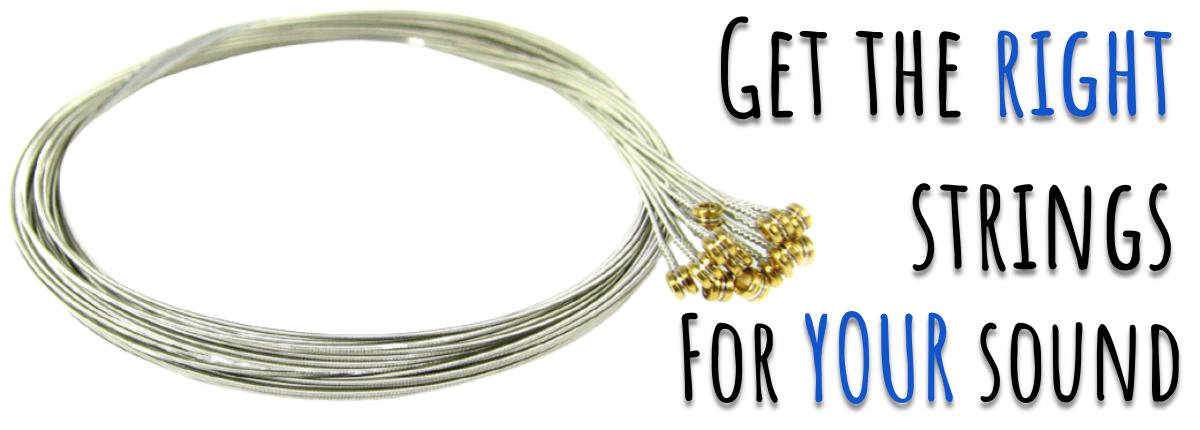
By Matt Gose
Posted 05/03/2022
Tone — the guitarist’s ever-elusive obsession. While electric guitars utilize all kinds of gadgets and gizmos to shape their overall sound, acoustic guitars have far less to hide behind. Something as simple as strings, for example, can have a major impact on how your acoustic guitar sounds. With so many options available, which strings will help you capture the best version of your personal sound?
Two Types of Guitar: Classical and Acoustic
Choosing the right strings begins with something so obvious yet so crucial — body style. With non-electric guitars, there are two main categories — Classical and Acoustic.
Classical Guitars, often used for folk music, flamenco, and — you guessed it — classical guitar styles, use nylon strings. Nylon strings are more soft and supple than their metal counterparts; they’re ideal for plucking, picking, and Rasgueado, without wearing your fingertips down to the bone. Because classical guitars are generally more fragile and delicate, steel strings could cause them serious harm!
Acoustic Guitars use strings made of metal — an alloy wrapped around a steel core. These metal strings vary in thickness and can be made from different materials.
Materials
Classical guitars are among the oldest styles of stringed instruments around. While most classical guitars today use strings made of synthetic materials, there are some players who stay true to classical form, preferring natural strings.
Synthetic Nylon strings are a modern adaptation of the strings used by early classical players. They can be made out of a variety of materials, though nylon is the standard. Nylon strings feature three treble strings made of pure nylon with three silver-wrapped bass strings.
Natural strings were more relied upon by musicians before the age of metal. Being a guitarist back then required guts… literally. Intestines — usually from cattle or other animals — were used to make strings. While they are uncommon today, there are still a few diehard players who prefer the more antiquated methods.
Gauge
Gauge refers to the thickness in diameter of the strings, and are measured in thousandths of an inch. The smallest gauges are called Extra-Light with the thickest gauges being Heavy.
Gauge sizes often go by the smallest string in the set. For most medium gauges, the smallest string is around .012 or .013 inches, so they are called “12s,” or “13s.” Extra Light strings are usually about a 10 (.010 inches), while heavy gauge strings can go up to 14 (.014 inches.) or more.
Lighter Gauge strings are typically more gentle and easy to play. They have a brighter, sharper tone, and are easier to bend, making them ideal for playing leads or more subtle, technical playing. They’re also relatively quiet, though they are prone to fret buzz, especially on guitars with lower action. Being lighter overall, they exert less tension on the neck, making them well suited for older or smaller-body guitars
Lighter gauge strings are not ideal for heavy strumming or situations requiring louder output.
Heavy Gauge strings can be much harder on the fingers — great for building up those calluses, not so great for learning proper fingering early on. Heavier strings require more pressure to the fretboard, but produce more volume and sustain than lighter strings. They also can withstand much heavier strumming.
Exerting more tension on the guitar’s neck, they’re optimal for larger-body guitars.
Coatings
Dwelling inside every metal guitar string is a core. For treble strings, the cores usually consist of tin-plated steel. For bass strings, these cores are typically solid steel wrapped in one of a handful of alloys.
80/20 Bronze was developed in the 1930s by John D’Addario and John D’Angelico. The name is a bit misleading, as the strings actually consist of 80% copper and 20% zinc. These strings produce a bright, shimmering tone. However, they do tend to oxidize relatively quickly, meaning they require frequent changing.
Phosphor Bronze strings tend to have a much longer lifespan than 80/20s. They’re made of copper with 8–10% tin and a small percentage of phosphorus. They produce a much more subdued tonal profile that doesn’t degrade as much throughout the lifespan of the strings.
Other Coatings
While 80/20s and Phosphor Bronze are the most popular, there are a number of other string varieties, including aluminum bronze, nickel, and more. Experimenting with different alloys can help you refine and solidify your personal tone.
Winding
Not only are guitar strings coated in different materials, but those coatings can also be wound differently around their steel core.
Roundwound strings are most commonly used, and give off a bright charm with defined harmonic overtones. They are incredibly responsive, adapting to most playing styles and sounds.
Flatwound strings are used more by Jazz players, and while they are almost exclusively made for electric guitars, there are a handful of brands out there that make them for acoustic guitars. Flatwound strings include a layer of polished ribbon that contributes to a mellow sound and reduces finger noise.
Strum to Your Own Tune
Because acoustic guitars typically create much more intimate tones, choosing the right strings for your style can make a seismic difference in shaping your sound. Try out a few different varieties, gauges, and coatings to find the ones that sound most like you!
